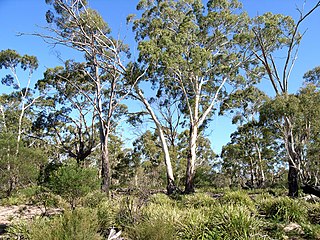
Eucalyptus viminalis, commonly known as the manna gum, white gum or ribbon gum, is a species of small to very tall tree that is endemic to south-eastern Australia. It has smooth bark, sometimes with rough bark near the base, lance-shaped to curved adult leaves, flower buds in groups of three or seven, white flowers and cup-shaped or hemispherical fruit.

Eucalyptus cypellocarpa, commonly known as mountain grey gum, mountain gum, monkey gum or spotted mountain grey gum, is a species of straight, smooth-barked forest tree that is endemic to southeastern Australia. It has relatively large, lance-shaped to curved adult leaves, flower buds in groups of seven, white flowers and usually cylindrical or barrel-shaped fruit.
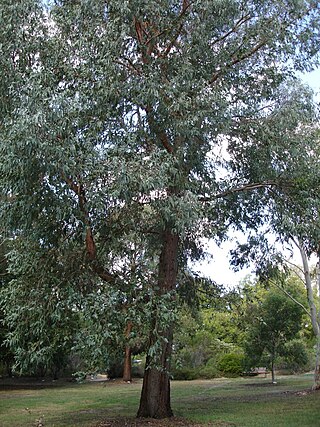
Eucalyptus chapmaniana, commonly known as the Bogong gum, is a species of small to medium-sized tree endemic to montane and eastern Australia. It has rough, fibrous and fissured bark on most of the trunk and smooth light brown to grey bark often shed in long ribbons on the branches. The adult leaves are lance-shaped to curved, the flower buds in groups of three and the fruit a conical or bell-shaped capsule.

Eucalyptus cinerea, commonly known as the Argyle apple, mealy stringbark or silver dollar tree, is a species of small- to medium-sized tree that is endemic to south-eastern Australia. It has rough, fibrous bark on the trunk and branches, usually only juvenile, glaucous, egg-shaped evergreen leaves, flower buds in groups of three, white flowers and conical to bell-shaped fruit.

Eucalyptus pulverulenta, commonly known as silver-leaved mountain gum, is a species of straggly tree or mallee that is endemic to southern New South Wales. It has smooth bark, egg-shaped, heart-shaped or round, sessile leaves arranged in opposite pairs, flower buds in groups of three, white flowers and cup-shaped to cylindrical fruit.

Eucalyptus miniata, commonly known as the Darwin woollybutt or woolewoorrng, is a species of medium-sized to tall tree that is endemic to northern Australia. It has rough, fibrous, brownish bark on the trunk, smooth greyish bark above. Adult leaves are lance-shaped, the flower buds are ribbed and arranged in groups of seven, the flowers orange or scarlet and the fruit is cylindrical to barrel-shaped or urn-shaped, with ribs along the sides.

Eucalyptus todtiana, commonly known as coastal blackbuttpricklybark or dwutta, is a species of tree or a mallee that is endemic to the west coast of Western Australia. It has rough, fibrous and flaky bark on the trunk, smooth bark on the branches, lance-shaped adult leaves, flower buds in groups of between seven and eleven, white flowers and cup-shaped to hemispherical fruit.

Eucalyptus globulus subsp. bicostata, commonly known as the southern blue gum, eurabbie, blue gum or Victorian blue gum, is a subspecies of tree that is endemic to south-eastern Australia. It has mostly smooth bark with some persistent slabs of old bark at the base, juvenile leaves with one glaucous side, glossy, lance-shaped adult leaves, warty flower buds in groups of three, white flowers and hemispherical to conical fruit.
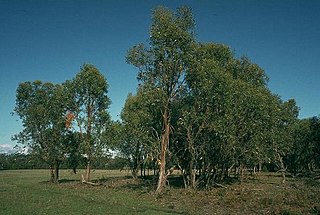
Eucalyptus kitsoniana, commonly known as the Gippsland mallee or bog gum, is a species of small tree or mallee and is endemic to Victoria. It has mostly smooth bark, a crown containing juvenile, intermediate and adult leaves, flower buds in groups of seven, white flowers and sessile, cup-shaped to hemispherical fruit.

Eucalyptus parvula, commonly known as small-leaved gum, is a species of small tree that is endemic to south-eastern New South Wales. It has mostly smooth bark, elliptical to lance-shaped adult leaves but with many juvenile of intermediate leaves in the crown, flower buds in groups of seven, white flowers and cup-shaped fruit.

Eucalyptus brookeriana, commonly known as Brooker's gum, is a tree species that is endemic to south-eastern Australia. It has rough, fibrous bark on the lower part of its trunk, smooth bark higher up, lance-shaped, egg-shaped or curved adult leaves, flower buds usually arranged in groups of seven, white flowers and cup-shaped, conical or bell-shaped fruit.

Eucalyptus kartzoffiana, commonly known as the Araluen gum, is a species of medium-sized tree that is endemic to a small area of southeastern New South Wales. It has rough, fibrous or flaky bark on part or most of its trunk, lance-shaped or curved adult leaves, flower buds in groups of three, white flowers and sessile, bell-shaped fruit.

Eucalyptus bridgesiana, commonly known as apple box, apple, apple gum or but-but, is a medium to large sized tree. It has rough, fibrous bark on the trunk and larger branches, smooth grey bark above, glossy green, lance-shaped adult leaves, flower buds in groups of seven, white flowers and hemispherical fruit.
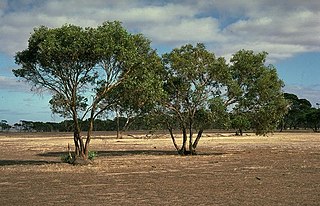
Eucalyptus behriana, commonly known as bull mallee and broad-leaved box, is a species of mallee or small tree that is endemic to south-eastern Australia. It has rough, fibrous bark on the lower part of the trunk and smooth bark above, broadly lance-shaped adult leaves, flower buds in groups of seven, white flowers and cup-shaped or barrel-shaped fruit.
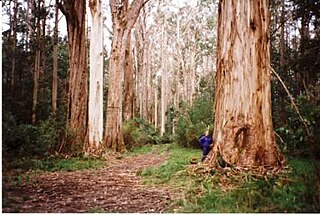
Eucalyptus denticulata, commonly known as the Errinundra shining gum or shining gum, is a species of tree endemic to south-eastern Australia. It has mostly smooth, white bark, lance-shaped to curved adult leaves with toothed edges, flower buds in groups of seven, white flowers and cup-shaped, barrel-shaped or cylindrical fruits. It is similar to E. nitens and was previously included in that species.

Eucalyptus serraensis, commonly known as the Grampians stringybark, is a species of small tree or mallee that is endemic to the Grampians in Victoria, Australia. It has rough, stringy, fibrous or flaky bark on the trunk and sometimes also the branches, smooth bark above, lance-shaped to egg-shaped or round adult leaves, sessile flower buds in groups of three or seven, white flowers and hemispherical or cup-shaped fruit.
Eucalyptus conspicua, commonly known as Gippsland swamp-box, is a species of small tree that is endemic to southeastern Australia. It has rough, thick, fibrous bark from the trunk to its small branches, lance-shaped to curved adult leaves, flower buds in groups of seven, white flowers and conical or hemispherical fruit. The crown of the tree is composed of a dull bluish-green juvenile, intermediate and adult leaves.
Eucalyptus croajingolensis, commonly known as the East Gippsland peppermint or Gippsland peppermint, is a species of tree that is endemic to southeastern Australia. It has rough, short-fibrous bark on the trunk and larger branches, sometimes smooth bark on the thinner branches, lance-shaped to curved adult leaves, flower buds in groups of nine or more, white flowers and hemispherical to cup-shaped fruit.
Eucalyptus filiformis is a species of mallee that is endemic to a small area on the side of a mountain in Victoria, Australia. It has rough fibrous or flaky bark on the trunk, smooth bark above, narrow lance-shaped to narrow elliptical adult leaves, flower buds usually in groups of seven, white flowers and barrel-shaped fruit.
Eucalyptus litoralis, commonly known as Anglesea box, is a species of tree that is endemic to a small area in Victoria. It has rough but thin, fibrous bark on the trunk, smooth pale grey bark on the branches, lance-shaped to curved adult leaves, flower buds in groups of seven, white flowers and cup-shaped or barrel-shaped fruit.

















